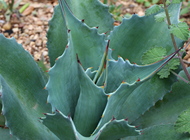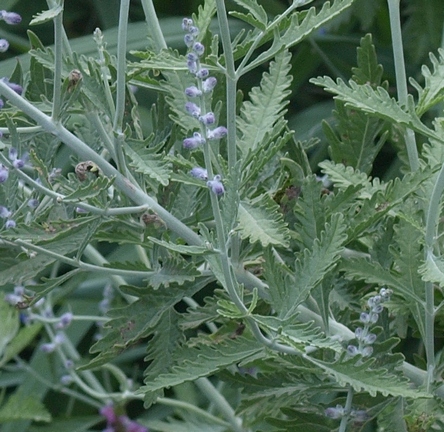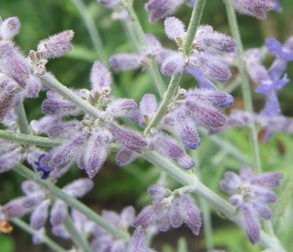 |
Perovskia atriplicifolia |
 |
| Common name |
Russian sage |
| Family |
lamiaceae |
| Life cycle |
perennial (Z4-9) |
| Flowers |
light blue (late summer) |
| Size |
2-3' |
| Light |
sun |
| Cultural notes |
ordinary garden soil (drought-tolerant) |
Silvery foliage, upright plant. Blooms, quite usefully, in mid-summer, when blues are hard to come by in the garden. We grow two varieties: the common species, and P. abrotanoides, a.k.a. Caspian Russian sage, purchased from Bluestone years ago. According to the nursery, the latter have darker-colored flowers, but I've detected no difference whatsoever. For what it's worth, the photo at the right is of the supposed Caspian variety.
|

| | Contrasting pleasantly with spent liatris flowerstalks and grasses |
|

| | Attractive gray-green leaves with feathery serration |
|
We left this plant behind in our Pennsylvania garden (and wish it well); we don't grow it in Houston. About my plant portraits
PlantLinks to other web pages about Perovskia atriplicifolia
Visitors to this page have left the following comments| Ferdzy | Nov 06, 2005 | I used to love this plant, but after the first 3 years in my garden, it began sending runners out all over the place. They are hellish to remove, and in spite of all of its good points, I would rip it all out, if only I could. I think it may eat not only my garden, but my entire town, if not stopped. Mine is also a good 5 feet tall.
I wonder in which zone you garden. I haven't noticed any invasive tendencies, but according to this page, it can become troublesome in mild climates. |
| Tracey | Jun 05, 2006 | I love this plant--especially in winter when the silvery stems add much winter interest--It does send out runners, but they're very easy to pull and snip off--and move to other areas of the garden! (zone 6) |
| Irena Montuori | Oct 11, 2009 | I agree with Ferdzy (Nov.6,2005 comment), this plant is taken over my garden, I live in zone 5 - although it is a beautiful plant, I have too much of it and the roots are really hard to dig up. Best is planted all by itself and provide enough space to spread.
You must be much nicer to your plants than I am! Mine are still there after six or so years in the same place, but haven't shown any inclination to expand beyond their limited space. They are planted in low- to medium-fertility soil that can get dry in the heat of summer. |
| Jeanette Broekhuis | Jul 24, 2011 | This plant is blooming beautifully (and as Rob says, quite usefully) in the garden of a nursing home here in Holland (mild climate). My friend who lives there cannot see much anymore, but sits and looks at this all day from her window or the chair just outside her door. For her this plant is a precious gift. I have room in my own yard for a spreading plant, so I'm willing to risk it. Any experience with propagation?
Although I believe this plant can be propagated both by seeds and by cuttings, I've not successfully done either. They don't self-seed around here, and my one attempt to grow from cuttings failed. But I'm not very good with cuttings. |
I welcome comments about my web pages; feel free to use the form below to
leave feedback about this particular page. For the benefit of other visitors
to these pages, I will list any relevant comments you leave, and if
appropriate, I will update my page to correct mis-information. Faced with an
ever-increasing onslaught of spam, I'm forced to discard any comments including
html markups. Please submit your comment as plain text. If you have a
comment about the website as a whole, please leave it in my
guestbook. If you
have a question that needs a personal response, please
e-mail me.
Last modified:
December 16, 2017
Contact me
|






